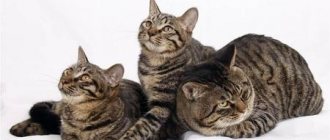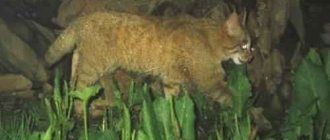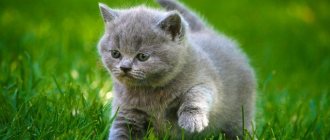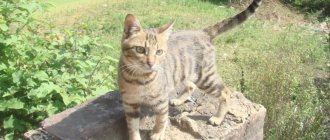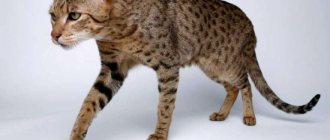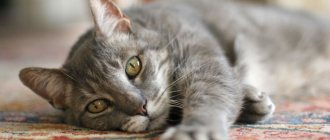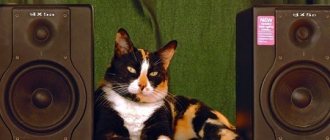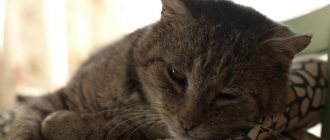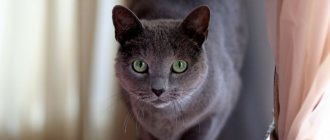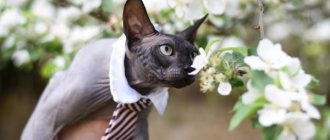Proper care and feeding
Chinese Li Huas love free space, so it is preferable to keep them in a private house or a spacious apartment, where they will have their own place.
If such an animal is given freedom, it will never go far from home, since it prefers warm rooms rather than cold streets. Caring for this breed is extremely easy. You only need to comb the coat a couple of times a week, and during the shedding period it is better to do this daily. You should bathe no more than 2 times a year. Since Li Hua are sensitive to drafts, they must be dried with a hairdryer after water treatments. And also in cold seasons, it is best to dress these cats in special clothes so that they do not catch a cold.
Every month it is necessary to trim the nails, but this is only if the pet is completely indoors and does not go outside. You should only cut off a couple of millimeters so as not to touch the blood vessel. Periodically, you need to wash your ears and eyes with a cloth soaked in warm water.
Due to the fact that such cats had wild ancestors, they love to sharpen their claws, so it is imperative to purchase a scratching post for them. It is best that it be vertical and have a rope made of natural fibers. To train your pet to use a scratching post rather than wallpaper or furniture, you can drop a couple of drops of valerian on it. It is advisable to purchase a tray with high sides and keep it clean.
Breeders prefer to feed such cats with premium ready-made dry or wet food. But if you wish, you can accustom your pet to natural products. In this case, it is necessary to add vitamins to the diet. Chinese cats have an excellent appetite and their diet should be balanced and enriched with proteins. This breed has no tendency to be overweight.
It is advisable to feed Li Hua at the same time. Adults need to be given food twice a day. It shouldn't be cold or hot. If the diet is mixed, then natural food must be served separately from prepared food. For example, feed dry food in the morning and natural food in the evening.
You can feed:
- lean meat;
- vegetables;
- porridge;
- offal;
- boiled sea fish;
- low-fat and natural dairy products (infrequently);
- soft bones and cartilage (not fish or chicken).
Meat, vegetables and cereals must be boiled before serving. Sweets, pork, sausages, fatty dairy products, salty foods and fruits should be excluded from the diet. The animal should have two bowls - for food and water. Cats should always have access to quality drinking water.
Li Hua have relatively good health and immunity. In addition, this breed does not have pronounced genetic diseases. They are very sensitive to drafts due to the lack of undercoat, so they should always be kept warm. Once every six months, Chinese cats require examination by a veterinarian, as well as regular vaccinations. Be sure to protect your pet's fur from insects and parasites. If all recommendations for care and feeding are followed, such pets can live 14-15 years.
Unfortunately, this breed has not become widespread and today there are very few of their representatives. It is quite difficult to purchase such an animal outside of China, since only there are several breeders breeding this breed. Therefore, the prices for Li Hua kittens are quite high.
Health
The Chinese cat breed was formed naturally, so it has excellent health and immunity. She has no genetic or hereditary pathologies, but problems may arise with age.
There are the following: hair loss, gastrointestinal diseases, with improper feeding - obesity, inflammation in cats after castration. Causes of disease: lack of vitamins, minerals, sedentary lifestyle. With proper care, they reach the age of 14-15 years.
Cat behavior
Due to its lifestyle and habitat, this breed is rarely found in nature. Unfortunately, the study of cats was suspended in 1985. At that time, it was based on observations made in a Chinese zoo, where 34 representatives of the breed lived permanently.
A characteristic feature of the behavior of the “Chinese” (kittens, whose photos are fascinating and touching, behave almost the same as adults) is a nocturnal lifestyle. Maximum activity occurs at night and morning. Representatives of this breed prefer to stay separately - females and males live in different places. Their burrows also have significant differences. For example, a female’s home is protected and quite reliable.
In order to achieve maximum results when catching prey, Chinese cats rely entirely on their hearing. Thanks to artificial research, it was found that representatives of the breed are able to track clatter and moles while they move at a distance of 5 cm underground. Cats of this breed dig out their prey very quickly.
Dragon Li
Dragon Li, or Li Hua, or Li Mao.
More recently, a unique breed of cats originally from China, the Dragon Li, has gained worldwide popularity. Back in 2003, this breed was presented to the world community for the first time at the Beijing exhibition. And from this moment the official countdown begins in the history of this exotic breed. Despite the fact that its numbers are not so large, this breed has long enjoyed popular love in its homeland.
In China, this breed is called slightly differently - Li Mao or Li Hua. The dragon name for this breed was borrowed from ancient manuscripts (many historical documents mention its name), it is used only in Western countries, emphasizing the cultural connection of the mythological Chinese dragon with these cats.
A preliminary standard for this breed was developed in 2005, but it was officially recognized only in 2010. At the same time, the Li Dragons were taken outside their homeland for the first time. Today, the Li Mao breed is bred not only in China, but also outside of it in the United States.
These cats develop a little more slowly; cats from three years of age are considered adults. Kittens should be purchased only after twelve weeks of age, as they are still too weak before this time.
Description.
For a person who is little familiar with this breed, it will not be easy to recognize Dragon Lee from an ordinary cat, because at first glance they are very similar. However, Dragon Li has a muscular and strong build, strong and proportionate legs and a straight back. The front legs are the same length as the hind legs, but may be slightly shorter. The head is elongated and graceful with a round forehead. The wide ears are neatly rounded, the tail is long, but slightly shorter than the length of the body, smoothly tapering to the tip.
You can recognize Dragon Li by his beautiful almond-shaped eyes, green or yellow. They also have such a distinctive feature as slightly luxurious eyes: the inner corners of the eyes are slightly lower than the outer ones. There must be black dots near the mouth, which create the illusion of a smile.
These cats have practically no undercoat, but the fur itself is dense, short and two-layered. Cats have silkier and softer fur than cats. The Lee Dragon has only one recognized coat color - brown tabby: the tip of the tail must be black, the rest of it must be colored with rings, and there must be black stripes on the head. There should be at least one continuous stripe running across the chest, shaped like a necklace. Each individual hair should be colored in several shades, which make up three clear stripes: dark brown, light brown and black.
Character.
Fans of this breed appreciate the Dragon Lee for its affectionate, calm character and intelligence. They love to play and get along with other animals, but it will not be easy for them to live in a family with small children. This breed is easy to train because they are very smart and loyal to their owners.
Grooming.
These are not particularly picky animals in everyday life and require special care. You only need to take care of the animal’s skin and fur - comb the hair once a week and clean the ears occasionally. It would be a good idea to get a scratching post, as these cats love to sharpen their claws. Li's dragons very rarely get sick, apparently due to the fact that the breed appeared in natural conditions. Still, it would be better to protect these cats from the cold, since they do not tolerate temperature changes well. As for the life expectancy of this cat breed, there is none, since the breed was registered quite recently.
Breeds of cats with brindle color
In almost every yard there is a cat or she-cat with a brindle color. Therefore, for many, this color is associated with purebredness. However, in the world everything is completely different and a tiger cat in the house is a sign of wealth, since tabby cats are very popular.
Toyger
Cat breed Toyger
Outwardly similar to a tiger. The toyger is a large animal with a muscular build, wide bones, and high shoulders. The head is long, medium in size with small rounded ears. The eyes are brightly colored and round. The upper eyelid is slightly drooping. The nose is long.
Females weigh 3.5-5, males 5-7.5 kg.
The paw pads and tip of the tail are black. The classic “tiger” pattern is the standard for the toyger. The color includes black, brown and yellow-brown shades. Circular stripes on the muzzle.
We invite you to familiarize yourself with: Terrarium for grape snails
Toygers are calm, flexible, friendly, and sociable. They are smart, easy to learn games and tricks. They love water and swimming. They communicate well with children and other inhabitants of the house.
There is a nursery in Moscow where these animals are cared for; the cost of a kitten starts from 60 thousand rubles.
Oncilla
Cat breed Oncilla
Its color and build resembles a jaguar. She has a bright spotted color. She is the size of a regular house cat. Oncilla is a wild animal with a crepuscular lifestyle. Loves to climb trees and swims well. The beast is cruel and aggressive. It's better not to keep him at home. An unusual pet is usually kept in an enclosure.
The character is obstinate, loves loneliness. Activity at night, jumping ability, hunting for small animals cause trouble for the owner.
It is better to feed the animal beef and live food with mineral and vitamin supplements. The animal is fed once a day.
Bengal cat
Bengal cat
Looks like a leopard. This is a large-sized cat with an elongated, muscular body. Their hind legs are longer than their front legs. Thick, silky coat with dense undercoat, patterned with stripes, spots or rosettes. Color from light golden to chocolate brown
Important! Paw pads and tail tip are black
Bengal cats are sociable, playful with a peaceful, affectionate nature. They are attached to their owner and love to walk with him down the street on a leash. Bengals are mobile, active, friendly with children and household members. They like games at heights. Bengals love water and love to swim. There is no need to comb them out.
It is better to feed cats natural food: meat, poultry and dairy products. You can use ready-made premium brand food with all the necessary vitamins. Bengal cats have good health and live up to 15 years.
Kittens cost 35-40 thousand rubles. In Russia there are nurseries in large cities where you can pick up a cheerful, active kitten who is easy to get along with.
The color of cats is striped or spotted, similar to a tiger. Animals are calm, affectionate, energetic, and inquisitive.
Tabbies are homebodies, love solitude, and relax in a secluded corner. They don't need anyone's company
Important! Suitable for single, busy people. Tolerant of people and pets
Feed 3-4 times a day in small portions, preferably natural products.
Tabbies have good health, strong immunity, and live 15-20 years.
There are only two nurseries with this breed in Russia. The price of a kitten ranges from 20 to 70 thousand rubles.
Sokoke
Sokoke cat breed
Cats are sensitive, prone to nervous disorders, neuroses, and seizures.
Animals are fed balanced feed with vitamin E and taurine to strengthen the cardiovascular system and improve metabolism. There is only one nursery in Moscow dedicated to this breed. A kitten costs from 30 to 100 thousand rubles.
Savannah
Savannah cat breed
Caring for them has its own characteristics. Savannahs do not like the cold, they love to jump, swim in the pool or in the nearest body of water. Long walks are recommended for pussies. An adult cat is almost half a meter tall and weighs up to 14 kg.
Cats of this breed live a long time - 17-20 years.
The animal must be fed meat and offal. Dairy products and foods high in grains should not be given. Can be fed with premium dry food. There is only one nursery with this breed, it is not in Russia. Kittens can cost from 500 thousand to 1.5 million rubles.
Conservation and study
The peak of study of this breed came from 1973-1985, when 34 cats were selected to be kept in a zoo to study the animal. The data collected at that time is the only information about this species of animal.
It is one of the top five most endangered felines and is listed on Appendix II of CITES.
Such a sharp decline in population is associated with a decrease in habitat due to human activity.
Chinese cats, by intuition, are accustomed to sharpening their claws much more often than other representatives.
One reason is the use of zinc salts as a way to get rid of rodents. But cats that ate poisoned rodents also died. After studying the drugs and confirming that they are harmful to all mammal species, the use of zinc in soybeans has been reduced. But it was never possible to restore the Chinese cat population.
Protecting such a beautiful endemic is a human responsibility. If you do not deprive it of its natural habitats, do not carry out work in the mountainous areas of Tibet and do not densely populate the Chinese steppes, then the extinction of the mammal can be successfully prevented.
Description of the standard appearance of the Dragon Lee cat
All representatives of the breed have a muscular and strong build, although they are of medium size. So the weight of cats is 3.5 kg, but males will be larger, their parameters do not exceed 5 kg.
- The body
is characterized by proportionality, the body is slender, while its outline resembles a rectangle with a wide chest. The length of the body exceeds the height parameters. If you look at a cat from the side, its back should appear almost completely straight. - The head
of cats of the Li Hua breed has an elongated shape, with a rounded forehead. It is curious that the corners of the pet’s mouth are distinguished by a black color, which gives the impression that the cat is constantly smiling. - The eyes
are quite large, their contours resemble almonds, the eyes are set obliquely (the inner corner is always higher than the outer). Their color stands out very brightly against the background of the fur - it takes on shades of green or yellow. - The ears
are medium in size, widening at the base, while the top is rounded. - limbs
are equal in length or the front limbs may be shorter in length than the hind limbs; they are distinguished by straight outlines and muscularity. - The paws
of Li Hua Mau cats are large, oval and wide in shape. There are five toes on the front paws and only four on the hind paws. - The tail
is slightly shorter in length than the body; at the base it has a thickening that smoothly tapers towards the end. - The coat
of Dragon Li cats is short, smooth, soft and silky to the touch. The undercoat is very weakly expressed. The wool covering is dense and has two layers. Typically, females have softer fur than males. - The coat color
of representatives of the Li Mao species is only chocolate broken tabby-merkel or brindle black tabby. There are stripes on the body and head of the animal, the chest seems to be decorated with a necklace (at least one continuous stripe), black lines also follow from the eyes and the lower outlines of part of the cheeks leading to the neck, the belly is covered in specks of a black tone, the tail process has black ring markings , which also move to the limbs. The legs above the wrist take on a brown color. The tail is black at the top. These patterns make Li Hua's cat look quite striking, as the tabby pattern stands out clearly against the ticked coat. All this is due to the fact that each individual hair has a color of encircling stripes, which are black in the root zone, the middle zone has a light shade, and at the top it changes to a chocolate tone. Full maturation of an animal is possible only when it reaches three years of age. Kittens of the Dragon Li breed are offered for sale only when they reach one year or 16 months. Then you can not only transport them, but also take them to exhibitions.
Important!
Although representatives of the Li Hua breed are similar to yard cats, there are also signs that can disqualify them - an incorrect bite, the presence of extra toes on the paws, defects in the tail process, elongated or wavy hair, whitish paws of the same color. the muzzle, the tip of the tail are not black, the nose is lightened, there are no stripes on the chest that resemble a necklace.
Chinese or Gobi gray cat and description
August 16, 2022 Lyudmila page » Wild cats 264
Chinese cat, Chinese desert cat, Chinese mountain cat, Gobi gray cat - all these are the names of one cat.
It belongs to the subfamily of Small cats (Felinae), the genus of cats (Felis), the species of Chinese cats (Felis bieti - in honor of the French missionary and naturalist Felix Bie).
The Chinese themselves call this cat “huang mo mao”, which literally means: “a cat that lives in a desert area with sparse vegetation.” Since 1992, this cat was officially renamed the Chinese mountain cat, because... now it is found only in the mountains of China.
Appearance of a Chinese gray cat
This cat is slightly larger than the average domestic cat and is very similar in appearance to the European wild cat (Felis silvestris).
The cat's body is stocky. The body length of the Chinese cat is from 1 to 1.5 meters. A third of the length (from 29 to 35 cm) is on the tail. Height at withers is from 30 to 35 centimeters. Weight ranges from 4.5 to 9 kilograms. The legs are short relative to the body.
The head is wide with large ears with black tassels (up to 2.5 cm) at the ends. The muzzle is round with a small nose and green eyes.
The tail is thick with 4-6 dark transverse rings, like a raccoon. The tip of the tail is black.
The coat is long and dense with a good thick undercoat. By winter it becomes longer and thicker. The color of the fur coat is gray-yellow in summer and gray-brown in winter. The lower part of the body is lighter than the back.
Habitat and lifestyle of the Chinese cat
The Chinese cat lives mainly in steppe and mountainous regions in northwestern China and southern Mongolia and Tibet, in the most extreme climatic conditions, where in summer the temperature rises to 40 degrees, and in winter it drops below 30 degrees due to strong winds. They prefer alpine meadows and areas covered with bushes. In the mountains they have been seen at altitudes from 2,800 to 4,100 meters above sea level.
The Chinese cat is a nocturnal animal that leads a solitary lifestyle. She is very careful and it is almost impossible to meet her in the wild. Females and males live separately. They spend most of their time in burrows. Moreover, females’ burrows are much deeper and more protected than those of males.
One cat occupies an area of about 12-15 km2.
Scientists studied all its habits from individuals that were in the zoo.
What does a Chinese cat eat?
The Chinese cat feeds mainly on rodents and small mammals: mice, rats, zokor, moles, gophers, marmots and rabbits. Sometimes they do not disdain lizards, birds (pheasant, partridge) and insects.
Thanks to their sensitive hearing, these cats find tsokors and moles by the sound of their movements underground. And having discovered prey, the Chinese cat instantly tears up the ground and catches rodents.
How does a Chinese cat reproduce?
During the breeding season (January to March), Chinese cats live together. Pregnancy lasts 2-2.5 months. Shortly before the kittens are born, the cat develops a hole or den in tree trunks.
Usually 2-4 cubs are born. Kittens grow quickly and at 7-8 months are already completely independent from their mother. At 8-12 months they can reproduce on their own.
Chinese cat population
In the wild, Chinese cats live from 10 to 12 years. Like all wild relatives, this cat suffers most from human activity. Thanks to the thoughtless and careless extermination of rodents in 1958 with the help of pesticides, many wild animals were poisoned along with the rodents.
For 20 years, the Chinese poisoned rodents with zinc phosphide until they realized that in this way they also killed all the carnivores that hunted these same rodents.
Also, because of the fur from which the Chinese sew traditional hats, the population of Chinese cats is sharply declining. Now the number of this cat barely reaches 10 thousand individuals.
Conservation status of the Chinese cat
To date, the Chinese cat is listed in the Red Book and in Appendix II of CITES. This is the only cat that is entirely Chinese.
Chinese cats do not pose any danger to humans and livestock. On the contrary, by increasing their numbers it was possible to do without 20 years of poisoning rodents and everything around them with chemicals. So, one thoughtless cry caused irreparable damage to all living things.
History of the discovery of the species
It is not known for certain where the animals came from; they approximately inhabited the territory of China long before the appearance of people and lived in desert areas. The separation of the Chinese and European (forest) cats occurred 230 thousand years ago. The cat was first described by the French zoologist and naturalist Henri Milne-Edwards in 1892. These animals lived in China long before the appearance of pets in Europe, where they were brought after the opening of economic borders.
Today, the Desert Cat is a small species, numbering from 2,500 to 10,000 adult individuals according to various sources, and these data are inaccurate. Not all animals have been domesticated by humans; small groups live in the remaining undeveloped areas of China.
Today they are facing extinction, as residential and industrial buildings occupy new territories every day, leaving no room for wildlife.
The dragon is often mentioned in Chinese proverbs
“After drawing a dragon, draw its pupils”
There are a huge number of common expressions about the dragon in the Chinese language.
- 龙争虎斗 (lóng zhēng hǔ dòu): “The fight between the dragon and the tiger” means a fight between two opponents of equal strength.
- 人中之龙 (rén zhōng zhī lóng): “Dragon among men”, an outstanding person of exceptional talent.
- 群龙无首 (qún lóng wú shǒu): “A flock of dragons without a leader” - when a group of people is left without a leader.
- 望子成龙 (wàng zǐ chéng lóng): “Hoping for a son to become a dragon” refers to parents wanting their children to succeed in life.
- 画龙点睛 (huà lóng diǎn jīng): “After drawing a dragon, draw its pupils” means to add the finishing touch.
By the way, on the Chinese New Year in the Celestial Empire it is customary to wish for “Fortitude of the dragon and horse.” Find out how to properly congratulate your Chinese colleagues and friends, listen to the audio and read Popular congratulations and what they mean.
External standards
The Chinese dragon looks very strong and its body is well built. Adult males weigh 5−6 kg, the body weight of females is 3−4 kg, the length of the body including the tail is 85−90 cm, the appendage occupies a third of the part. Cat appearance standards:
- round head with convex cheeks;
- almond-shaped eyes;
- chin is flat;
- the width of the nose is equal to the size of one eye;
- thick neck;
- limbs of medium length;
- short, harsh coat.
On the large head, the cat’s fleshy cheeks stand out, large, wide ears are set with a slight tilt forward, crowned with small tassels. Large, slightly slanted eyes should have a yellow iris. Animals with a green tint are also allowed at exhibitions, but they are valued much less. The wide nose is black or dark brown; light spots and stripes are not allowed. A well-developed chin appears flat when viewed in profile. The transition from forehead to nose is almost invisible.
The head sits on a short massive neck, the chest is quite deep and wide, very strong. Although the body of the Chinese cat is dense, it is built compactly and gracefully. All muscles are clearly visible under the smooth coat. The tail and limbs are of medium length, the paws are large, the pads are black or dark gray. Undercoat grows between the toes, and the claws retract when at rest.
The fur of the Chinese cat is short and quite hard. In a healthy animal it should have a glossy sheen. Only two types of color are allowed: golden brown or chocolate tabby. Dark stripes or spots are clearly visible on a light background; the letter “M” can be distinguished on the forehead. The neck is covered with a pattern resembling a necklace, the eyes are outlined in black, and the tail has evenly distributed rings.
These animals have rather large and almond-shaped eyes.
The camouflage appearance of "Lee's Dragons" allows the cats to be invisible to unwary prey in the wild, but it appears deceptively generic to humans. However, Li Huas are not deprived of their own charm, and the Chinese cat breed standard is determined by the following parameters:
- The back is straight, the body is proportional and slightly elongated.
- The coat is dense, but soft and tactilely pleasant, the undercoat is poorly developed.
- The head is slightly elongated, the forehead is round. Due to the peculiarities of the color, it seems as if the cat is constantly smiling.
- The eyes are almond-shaped, large, and located at an angle. The color contrasts with the coat, mainly taking on shades of green and yellow.
- The ears resemble isosceles triangles with medium-sized rounded tops.
- The legs are muscular and straight. The hind ones are longer or the same length as the front ones. There are 5 toes on the front paws and 4 on the hind paws.
Interesting Facts
Many sites write about supposedly another breed of Chinese cats, Maneki-neko, a symbol that brings happiness. In fact, this figurine, which is often made of porcelain or ceramics, came from Japan, not the Middle Kingdom, and looks like a cat waving its paw. It is sold in souvenir shops and is believed to bring prosperity and happiness to the home.
The history of Maneki-neko began in the early 17th century, when one poor monk sheltered a wild mountain kitten dying of hunger. The temple in which the man lived was in a terrible state. One day, out of melancholy and hopelessness, the monk spoke to the animal, saying that he did not blame him for being useless, but if the cat were a person, he could be more useful.
The next day a thunderstorm broke out. A prince was driving past the monastery and saw a Chinese cat on the road waving its paw. The beast showed the way to the shelter, where the traveler found food and shelter. The next day, a wealthy guest allocated funds for the restoration of the monastery.
Since then, Maneki-neko has been in every home and it is believed that happiness and good luck always follow it.
Is it possible to keep an animal at home?
The animal is nocturnal and camouflages itself very well, so it is almost impossible to study its habits in the wild. All descriptions are based on observations of zoo inhabitants. Males and females live separately; they spend most of the day in burrows that they create themselves. Females have deeper and more protected burrows. The living space of one individual is 12–15 square meters. km.
Wild cats have received protected status, so they can only be kept in zoos. However, some wealthy people buy animals from smugglers and try to make them into pets. Once in the presence of a person, a mountain cat usually finds a reliable shelter and spends most of its time there. During the mating season, she can become very aggressive.
In nature reserves and zoos, mountain predators always strive for solitude; they do their best to avoid contact with humans and other inhabitants of the territory. Animals in nature occupy vast spaces, so in captivity they also need space.
To keep animals of this breed at home, you will need a large enclosure where the predator will have a place to rest and a secluded nest among tree branches. In a house or apartment, wild individuals will instinctively look for a place hidden from human eyes, dig holes and build nests.
The habits of wild ancestors remain with predators that were taken into the home at an early age. It is impossible to train them to a tray and prohibit them from making night forays for the purpose of hunting. The pet will regularly mark the territory, sharpen its claws and create inconvenience for its owners at night.
In nature, animals constantly practice jumping and climbing trees. At home and when kept in an enclosure, they need to build shelves, stands, and slides so that the cats can maintain physical fitness and remain healthy.
In addition, wild pets that live at home require timely vaccination. The first vaccinations are given at the age of 8–12 months. Then the Chinese breed animals are vaccinated annually. It is quite difficult to treat wild predators, since they have poor contact with people. Trying to help an animal can result in injury for the veterinarian.
Regular food from the home table is not suitable for these predators. In nature, they eat only natural food, so at home they constantly need fresh natural meat. If there is not enough meat in the diet, the pet may develop diseases of the musculoskeletal system. The cat needs to get rodents and birds every day. To keep her healthy, the owner will have to take care of this.
How to choose the right kitten
Buying a Chinese Li Hua cat is quite difficult, because it is found only in its homeland and in the USA. Even in China it is not widespread, there are only a few nurseries there. Prices for kittens start at $1,000, and the cost of shipping the animal also falls on the buyer.
When choosing a Li Hua, you need to be very careful, because the breed is similar to an ordinary yard cat. You cannot trust sellers who post advertisements for sale on virtual bulletin boards - most often they are scammers. They do not have documents confirming their pedigree or vaccination certificates.
Those who have agreed to purchase a Chinese cat from a breeder from China or America need to make sure that the pet matches the description of the breed and is absolutely healthy. This can be judged by the following signs:
- the cat is active, playful, makes contact;
- he has clean eyes and ears;
- he is moderately well-fed;
- there are no bald spots on the body;
- the abdomen is soft, without signs of bloating.
Kitten care
Chinese kittens should not be separated from their mother before 12 weeks of age. Some breeders do not release them to new owners until 4 months. By this time, the babies are already accustomed to the tray and scratching post, and can eat from a bowl independently.
They can be fed with chopped lean chicken, turkey, veal, rabbit with the addition of vegetables. Also included in the kittens’ diet is low-fat cottage cheese, boiled eggs, and cereals.
Motor activity is very important for harmonious development. A cat needs a lot of space to run and play. Caring for her includes regular cleaning of her eyes and ears, combing her fur and shortening her nails.
Features of mating Chinese Li Hua cats
Chinese cats develop more slowly than other representatives of the cat world. They reach sexual maturity only after three years. It is strictly not recommended to breed them earlier, since early pregnancy can result in a miscarriage or even the death of the cat. Males are ready to mate after about two years of age. As a rule, a sexually mature female Li Hua does not have problems during the gestation period. Childbirth is easy and natural. Representatives of this slowly maturing breed can give birth no more than once a year.
It is difficult to find a partner for a Chinese cat
Breeding Chinese cats is extremely difficult, not only because of their small numbers, but also because of the low popularity of this breed. Visually, only a specialist can distinguish a purebred Li Hua from a simple yard dog. It will not be possible to find a partner for a pet in Russia; to do this you will have to visit China or the USA. When choosing a pair, consider the following:
- appearance of a potential partner: compliance with breed characteristics;
- health and activity.
purebred, there must be appropriate documents (club book, veterinary card, pedigree, etc.); availability of timely vaccination and regular prevention of parasite infection.
Pedigree cats must have pedigrees
Cat lovers I know say that when a breeder has few breeding animals, he often resorts to inbreeding. This fact negatively affects the health of the offspring, since the chances of developing genetic diseases or physical defects increase significantly. You should carefully study the pedigree up to the fourth generation.
Li Hua, Li Mao, Li Hua Mau, Li Hua Mao, Dragon Li
Story
The Dragon Li, or Chinese Li Hua, is descended from the Chinese mountain cat, which over the centuries has adapted to living with humans (this is called self-domestication). This version of the origin is still sometimes disputed, although it could not be completely refuted, since it is traditionally believed that all cats descended from the wild African cat. In any case, the breed really belongs to the ancients, since the first mentions of these cats date back to the first millennium BC.
Thus, we can say that the Chinese Li Hua is an aboriginal breed, which in the process of its development went through a period of domestication, and in more modern times was subjected to systematic breeding. Despite its popularity in China, this breed is considered rare, and, accordingly, these cats are expensive, especially outside their native country.
To roughly understand how rare they are, it is enough to cite just one fact - as of 2022, there were 4 purebred Li dragons in the United States. And this is in a country with a population of 250 million people. Chinese Li Hua is the hero of many legends and traditions, and is also mentioned in other works of folklore. Today the breed is recognized by the International Cat Fanciers Association and the Chinese Cat Fanciers Association.
She was first presented in 2004, at the Beijing exhibition, where American breeders learned about her. Several individuals were transported to the USA, and after just over 2 years, experts presented standards for the Li Hua breed. The New Breeding Association of the United States registered these cats in 2010.
Description
A rare and outstanding breed of cats, the Li Hua is a real hunter, a wild cat that came from time immemorial. At the same time, they are kind and affectionate with their family, and merciless, fearless in a fight. Possessing high intelligence, Li Huas love to observe those around them, can open cabinet doors and are well oriented in the area.
The breed has a large build, powerful bones, but is not devoid of purely feline grace and ease of movement. The paws are of medium length, muscular and strong, the ears are medium, the muzzle is wedge-shaped, slightly elongated. The average lifespan has not been established due to the small number of individuals, but by default it is believed that these cats, like others, live about 15 years.
Personality
Since the Chinese Li Hua Mao (this is another name of the breed), descended from wild mountain cats, it carries the genetic memory and primitive instincts of these animals. Therefore, if you live in a private house, you can be sure that your pet will be incredibly happy about it. He will climb trees, bask in the grass in the sun, hunt mice and birds - he is a wonderful hunter, by the way.
In relation to the owner and members of his family, the Chinese Li Hua shows affection and friendliness, and is always ready to warm loved ones with its warmth. However, he has an independent character and intelligence, if we were talking about a person, they would say about such a person - a strong personality. Thanks to inner confidence and strength, the cat has patience and calmness, and therefore normally perceives other pets. But - only if it is not a parrot, fish or guinea pig, since the li hua will definitely see prey in them.
Children and strangers are treated calmly, without negativity
They love and appreciate attention from their owners, and worry if they don’t receive it. Also, the Li Hua cat becomes strongly attached not only to people, but also to a place, and therefore adaptation to a new home is difficult.
Common diseases
Like other native cats, Chinese dragons do not have any health problems. These are hardy animals with strong immunity.
This breed is classified as short-haired, and therefore it is enough to comb the pet once a week. You can bathe once every 2 months or as needed. You also need to brush your teeth at least 3 times a week, trim your nails about once every 10 days, and clean your ears as they get dirty.
Chinese Li Hua Mao or Dragon Li, as they are also called, are very rare even in their homeland. In most countries, only connoisseurs have heard about them, and there is no need to talk about nurseries or the sale of kittens. Perhaps in the near future the situation will change in favor of furry dragons, because interest in everything Chinese is constantly growing.
How to choose the right kitten
Buying a Chinese Li Hua cat is quite difficult, because it is found only in its homeland and in the USA. Even in China it is not widespread, there are only a few nurseries there. Prices for kittens start at $1,000, and the cost of shipping the animal also falls on the buyer.
When choosing a Li Hua, you need to be very careful, because the breed is similar to an ordinary yard cat. You cannot trust sellers who post advertisements for sale on virtual bulletin boards - most often they are scammers. They do not have documents confirming their pedigree or vaccination certificates.
Those who have agreed to purchase a Chinese cat from a breeder from China or America need to make sure that the pet matches the description of the breed and is absolutely healthy. This can be judged by the following signs:
- the cat is active, playful, makes contact;
- he has clean eyes and ears;
- he is moderately well-fed;
- there are no bald spots on the body;
- the abdomen is soft, without signs of bloating.
Kitten care
Chinese kittens should not be separated from their mother before 12 weeks of age. Some breeders do not release them to new owners until 4 months. By this time, the babies are already accustomed to the tray and scratching post, and can eat from a bowl independently.
They can be fed with chopped lean chicken, turkey, veal, rabbit with the addition of vegetables. Also included in the kittens’ diet is low-fat cottage cheese, boiled eggs, and cereals.
Motor activity is very important for harmonious development. A cat needs a lot of space to run and play. Caring for her includes regular cleaning of her eyes and ears, combing her fur and shortening her nails.
External signs
At first glance, Dragon Li is no different from a mongrel domestic cat and an ignorant person cannot distinguish them. But of course, differences exist. Li Mao is a large, muscular cat with strong, strong legs and an even posture. Unlike most breeds, Li Hua's hind legs are the same length as her front legs. The tail is proportional to the length of the body and is quite thick.
The shape of the head is slightly elongated and has a graceful round forehead. The cat's face is round with an even profile and a massive chin. The eyes are the highlight of this breed. They have an almond shape and a slightly slanted fit. Eye color can be yellow or green.
Li Hua's coat is two-layered, thick and densely packed, but has practically no undercoat. Males' coats are usually rougher to the touch than cats'. The only color recognized as a standard is brown tabby. Black stripes should be on the head and throughout the body, the tail is covered with black rings, the tip is completely colored. Each individual hair of fur is colored in three shades: black, brown and light brown.
Li Hua, Li Mao, Li Hua Mau, Li Hua Mao, Dragon Li
Story
The Dragon Li, or Chinese Li Hua, is descended from the Chinese mountain cat, which over the centuries has adapted to living with humans (this is called self-domestication). This version of the origin is still sometimes disputed, although it could not be completely refuted, since it is traditionally believed that all cats descended from the wild African cat. In any case, the breed really belongs to the ancients, since the first mentions of these cats date back to the first millennium BC.
Thus, we can say that the Chinese Li Hua is an aboriginal breed, which in the process of its development went through a period of domestication, and in more modern times was subjected to systematic breeding. Despite its popularity in China, this breed is considered rare, and, accordingly, these cats are expensive, especially outside their native country.
To roughly understand how rare they are, it is enough to cite just one fact - as of 2022, there were 4 purebred Li dragons in the United States. And this is in a country with a population of 250 million people. Chinese Li Hua is the hero of many legends and traditions, and is also mentioned in other works of folklore. Today the breed is recognized by the International Cat Fanciers Association and the Chinese Cat Fanciers Association.
She was first presented in 2004, at the Beijing exhibition, where American breeders learned about her. Several individuals were transported to the USA, and after just over 2 years, experts presented standards for the Li Hua breed. The New Breeding Association of the United States registered these cats in 2010.
Description
A rare and outstanding breed of cats, the Li Hua is a real hunter, a wild cat that came from time immemorial. At the same time, they are kind and affectionate with their family, and merciless, fearless in a fight. Possessing high intelligence, Li Huas love to observe those around them, can open cabinet doors and are well oriented in the area.
The breed has a large build, powerful bones, but is not devoid of purely feline grace and ease of movement. The paws are of medium length, muscular and strong, the ears are medium, the muzzle is wedge-shaped, slightly elongated. The average lifespan has not been established due to the small number of individuals, but by default it is believed that these cats, like others, live about 15 years.
Personality
Since the Chinese Li Hua Mao (this is another name of the breed), descended from wild mountain cats, it carries the genetic memory and primitive instincts of these animals. Therefore, if you live in a private house, you can be sure that your pet will be incredibly happy about it. He will climb trees, bask in the grass in the sun, hunt mice and birds - he is a wonderful hunter, by the way.
In relation to the owner and members of his family, the Chinese Li Hua shows affection and friendliness, and is always ready to warm loved ones with its warmth. However, he has an independent character and intelligence, if we were talking about a person, they would say about such a person - a strong personality. Thanks to inner confidence and strength, the cat has patience and calmness, and therefore normally perceives other pets. But - only if it is not a parrot, fish or guinea pig, since the li hua will definitely see prey in them.
Children and strangers are treated calmly, without negativity
They love and appreciate attention from their owners, and worry if they don’t receive it. Also, the Li Hua cat becomes strongly attached not only to people, but also to a place, and therefore adaptation to a new home is difficult.
Character
Cats of the Li Mao breed are highly active and friendly. They do not show intrusiveness or aggression. They get along well with other animals... and, at the same time, are considered unsurpassed hunters - owners of pet rats, guinea pigs, hamsters, etc. need to take this into account.
It is better to have a pet of this breed in a house where there are no very small children (since “dragons” do not like excessive squeezing and caressing).
Also, Li Hua are very smart and loyal cats and are quite trainable. It is quite easy to train them to go to the litter box or sharpen their nails on a special scratching post.
The Li Mao breed is perfect for keeping in a small apartment. If the owners are on duty during the day, they can tolerate loneliness without any problems.
